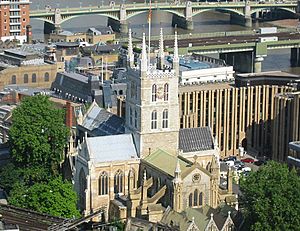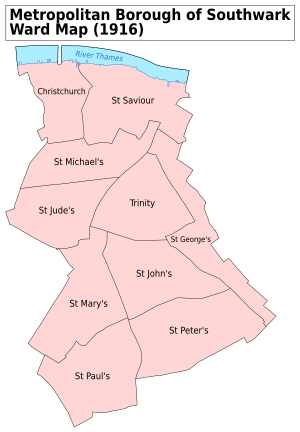Southwark facts for kids
Quick facts for kids Southwark |
|
|---|---|
 Southwark Cathedral, also called St Saviour's, for centuries known as St Mary's Overy, or Overie (short for "over-the-river") |
|
| OS grid reference | TQ325795 |
| • Charing Cross | 1.5 mi (2.4 km) W |
| London borough | |
| Ceremonial county | Greater London |
| Region | |
| Country | England |
| Sovereign state | United Kingdom |
| Post town | LONDON |
| Postcode district | SE1 |
| Dialling code | 020 |
| Police | Metropolitan |
| Fire | London |
| Ambulance | London |
| EU Parliament | London |
| UK Parliament |
|
| London Assembly |
|
Southwark (pronounced SUDH-ərk) is a lively area in Central London. It sits on the south side of the River Thames. This district is the oldest part of South London. It grew important because it was at the southern end of London Bridge, which was the only way to cross the river for many centuries. Around 43 AD, engineers from the Roman Empire chose this spot to build the first bridge because the land was suitable.
For a long time, the City of London (London's historic center) was north of the bridge. The area of Southwark just south of the bridge was partly controlled by the City. Other parts of Southwark were less controlled. One area, called Liberty of the Clink, became a famous place for entertainment. By the 12th century, Southwark became an ancient borough. This is why it's also known as Borough.
Over the years, Southwark grew. In 1900, it became completely separate from the City of London in terms of how it was run. Today, Southwark is home to many famous places. These include Southwark Cathedral, Borough Market, Shakespeare's Globe theatre, The Shard skyscraper, Tower Bridge, Butler's Wharf, and the Tate Modern museum.
Contents
History of Southwark
What's in a Name?
The name Suthriganaweorc or Suthringa geweorche was used for this area in the 10th century. It means "fort of the men of Surrey" or "the defensive work of the men of Surrey." In the 1086 Domesday Book, it was called Sudweca. This name means "southern defensive work." It comes from the Old English words sūth (south) and weorc (work). It's called "southern" because it's south of the City of London and at the southern end of London Bridge.
Until 1889, the county of Surrey included what is now the London borough of Southwark. The name "Southwark" has been used for different local government areas over time. The old area was also simply called The Borough or Borough. This name is still used today to tell it apart from 'The City'.
Southwark's Early Days
Southwark was built on land that used to be marshy, south of the River Thames. Digs have found signs of very old activity, like early farming, burial mounds, and special ceremonies. The area was originally a group of islands in the Thames. This made it the best place to build a bridge across the river. Southwark became very important to Londinium (the Roman name for London) because it was where the Roman London Bridge ended. Two Roman roads, Stane Street and Watling Street, met in Southwark.
Londinium was left empty when the Romans left in the early 5th century. The city and its bridge fell apart. Archaeologists found a layer of soil called the Dark Earth. This probably means the area was abandoned for a while.
Southwark started to recover around the time of King Alfred the Great and the kings who came after him. Around 886 AD, a "burh" (a fortified town) was built in Southwark. The old Roman city area was settled again. It was likely fortified to protect the bridge and the growing City of London to the north. This defensive role was important. In 1016, the bridge was used to defend against King Sweyn and his son King Canute. In 1066, it was used against King William the Conqueror. He couldn't force his way across the bridge during the Norman conquest of England, but Southwark was badly damaged.
The Domesday Book of 1086 mentions Southwark. It says that different Surrey manors owned parts of it. For example, Bishop Odo of Bayeux owned the monastery (where the Cathedral is now). The King owned a church and its tidal stream. The King and Earl Godwin, Earl of Wessex shared the fees from the waterway. The King also got tolls from the riverbank. The "men of Southwark" had the right to a "haw" (a piece of land) and its toll. Southwark was worth £16 to the King. Much of Southwark was originally owned by the church. Southwark Cathedral, which was once a priory called St Mary Overie, is the biggest reminder of this.
During the early Middle Ages, Southwark grew. It was one of four towns in Surrey that sent representatives to the first parliament in 1295. An important market was on High Street from the 13th century. The City of London's officers controlled it. Later, it was moved to its current spot as Borough Market to help traffic flow to the bridge. The area was also famous for its inns, like The Tabard. This is where Geoffrey Chaucer's pilgrims started their journey in The Canterbury Tales.
Just west of the bridge was the 'Liberty of the Clink' manor. The City never controlled this area. It was under the Bishop of Winchester's authority. Because of this, it became London's main entertainment district. It was also known for its less formal activities. In 1587, Southwark got its first theatre, The Rose. Philip Henslowe set it up, and it quickly became popular. Both Christopher Marlowe and William Shakespeare worked at The Rose.
In 1599, the Globe Theatre, where Shakespeare was a part-owner, was built in the Liberty of the Clink. It burned down in 1613 but was rebuilt in 1614. However, it was closed by the Puritans in 1642 and later torn down. A modern copy, called Shakespeare's Globe, has been built near the original site. Southwark was also a popular place for entertainment like bull and bear-baiting. Edward Alleyn, a colleague of Shakespeare, was a key person in these entertainments. He left money for many local charities, including Dulwich College.
On May 26, 1676, ten years after the Great Fire of London, a huge fire broke out in Southwark. It lasted for 17 hours. Houses had to be blown up to create fire breaks and stop it. King Charles II and his brother, James, were involved in fighting the fire.
Southwark also had a famous fair near the Church of St George the Martyr. The artist William Hogarth showed this fair in his famous picture Southwark Fair (1733).
Southwark was also home to several prisons. These included the Marshalsea and King's Bench prisons, and local manor prisons like Borough Compter and The Clink.
The Harvard family is another notable local family. John Harvard went to the local free school of St Saviour's and then to Cambridge University. He later moved to the Massachusetts Colony in America. He left his library and the rest of his money to a new college there, which was named Harvard University after him. Harvard University still has a connection to Southwark. They paid for a special chapel in Southwark Cathedral, which was his family's church.
Modern Southwark
In 1836, the first railway in the London area was built. It was the London and Greenwich Railway, which ended at Spa Road Station and later extended to London Bridge station.
In 1861, another Great Fire of Southwark destroyed many buildings. It affected the area between Tooley Street and the Thames, including around Hays Wharf (now Hay's Galleria).
The first deep underground railway line in London was the City and South London Railway. It opened in 1890 and is now part of the Northern line. It ran from King William Street south through Borough to Stockwell. Since 1999, Southwark has also been served by Southwark, Bermondsey, and London Bridge stations on the Jubilee line.
How Southwark is Governed
The old area of Southwark was made up of several parishes (small church districts). Over time, some of these parishes were combined or split.
In 1855, these parishes became part of the Metropolitan Board of Works. In 1889, the area became part of the County of London.
In 1900, local government changed again. The Metropolitan Borough of Southwark was created. It included some of the old Southwark parishes and the area of Newington. Other eastern parishes became part of the Metropolitan Borough of Bermondsey. In 1965, these two boroughs joined with the Metropolitan Borough of Camberwell to form the current London Borough of Southwark.
For a long time, Southwark was outside the direct control of the City of London. This meant it was a place where criminals and traders could operate without the strict rules of the City's trade groups. In 1327, the City gained some control over the area near London Bridge.
Later, in 1550, Southwark was officially made a part of the City of London as a "ward" called Bridge Without. However, the City still appointed its leaders, and the people of Southwark couldn't elect their own representatives to the City's council. This arrangement continued for centuries. Today, the London Borough of Southwark council runs the area. Its main offices are at 160 Tooley Street.
Places to See in Southwark

Like much of the south bank of the Thames, Southwark has changed a lot in recent years. Old docks, small factories, and industries have been replaced by new homes, shops, restaurants, art galleries, and offices. Many big international companies now have their headquarters here, especially along London Bridge City and More London. The area is close to the City and the West End, making it a major business hub. London's tallest skyscraper, The Shard, is right next to London Bridge Station.
To the north is the River Thames, London Bridge station, and Southwark Cathedral. Borough Market is a very popular place for visitors and has grown a lot. The nearby buildings have been turned into places to eat and drink, making it a food lover's paradise. Borough High Street runs from London Bridge south towards Elephant and Castle. Southwark extends further south than many people realize. Both St George's Cathedral and the Imperial War Museum are within its old boundaries.
Southwark was once famous for its entertainment, especially during Shakespeare's time with the Globe Theatre. This tradition has been brought back with the modern Shakespeare's Globe theatre, which opened in 1997. It has smaller theatre spaces and an exhibition about Shakespeare. The Southbank area, which is partly in Southwark, also has many art venues.
At the heart of the area is Borough. It has a unique covered market and many places to eat and drink. The towering skyscraper The Shard is also here. Borough is a mix of different types of buildings, including council housing, large office buildings, and fancy private communities.
Another important landmark is Southwark Cathedral. It was once a priory and then a parish church, becoming a cathedral in 1905. It's known for its Merbecke Choir. The area is still being redeveloped.
Getting Around Southwark
Southwark has three main underground stations: Borough, Southwark, and London Bridge station, which is also a major railway station.
Famous People from Southwark
- Michael Caine (born 1933), actor
- Bradley Gamble (born 1975), former footballer
- King Krule (born 1994), singer, songwriter, musician, rapper, and record producer
- Lucy Worsley (born 1973), historian, author, curator, and television presenter
- Sir Keir Starmer (born 1962), Prime Minister of the United Kingdom
See also
 In Spanish: Municipio de Southwark (Londres) para niños
In Spanish: Municipio de Southwark (Londres) para niños



